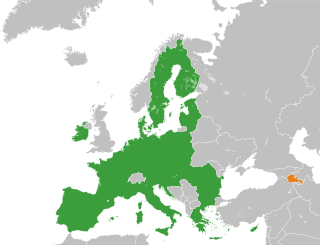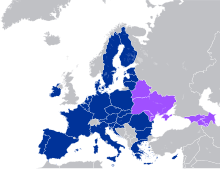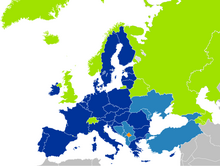
Nagorno-Karabakh is a region in Azerbaijan, covering the southeastern stretch of the Lesser Caucasus mountain range. Part of the greater region of Karabakh, it spans the area between Lower Karabakh and Syunik. Its terrain mostly consists of mountains and forestland.

Artsakh, officially the Republic of Artsakh or the Republic of Nagorno-Karabakh, was a breakaway state in the South Caucasus whose territory was internationally recognised as part of Azerbaijan. Between 1991 and 2023, Artsakh controlled parts of the former Nagorno-Karabakh Autonomous Oblast of the Azerbaijani Soviet Socialist Republic, including its capital Stepanakert. It had been an enclave within Azerbaijan from the 2020 Nagorno-Karabakh war until the 2023 Azerbaijani offensive, when the Azerbaijani military took control over the remaining territory controlled by Artsakh. Its only overland access route to Armenia after the 2020 war was via the 5 km (3.1 mi) wide Lachin corridor, which was placed under the supervision of Russian peacekeeping forces.

The First Nagorno-Karabakh War was an ethnic and territorial conflict that took place from February 1988 to May 1994, in the enclave of Nagorno-Karabakh in southwestern Azerbaijan, between the majority ethnic Armenians of Nagorno-Karabakh backed by Armenia, and the Republic of Azerbaijan with support from Turkey. As the war progressed, Armenia and Azerbaijan, both former Soviet republics, entangled themselves in protracted, undeclared mountain warfare in the mountainous heights of Karabakh as Azerbaijan attempted to curb the secessionist movement in Nagorno-Karabakh.

The Nagorno-Karabakh conflict was an ethnic and territorial conflict between Armenia and Azerbaijan over the region of Nagorno-Karabakh, inhabited mostly by ethnic Armenians until 2023, and seven surrounding districts, inhabited mostly by Azerbaijanis until their expulsion during the 1990s. The Nagorno-Karabakh region was entirely claimed by and partially controlled by the breakaway Republic of Artsakh, but was recognized internationally as part of Azerbaijan. Azerbaijan gradually re-established control over Nagorno-Karabakh region and the seven surrounding districts.

The Community for Democracy and Rights of Nations, also commonly and colloquially known as the Commonwealth of Unrecognized States, rarely as CIS-2, is an international organization in Eastern Europe and the South Caucasus of three breakaway states in the territory of the former Soviet Union, all of which have limited to no recognition from the international community.

The Republic of Artsakh was a republic with limited recognition in the South Caucasus region. The Republic of Artsakh controlled most of the territory of the former Nagorno-Karabakh Autonomous Oblast. It was recognized only by three other non-UN member states, Abkhazia, South Ossetia and Transnistria. The rest of the international community recognized Artsakh as part of Azerbaijan. In November 2012, a member of Uruguay's foreign relations committee stated that his country could recognize Nagorno-Karabakh's independence. In 2012, Armenia and Tuvalu established diplomatic relations, which led to speculation of possible recognition of Artsakh by Tuvalu. In October 2012, the Australian state of New South Wales recognized Nagorno-Karabakh. In September 2014, the Basque Parliament in Spain adopted a motion supporting Artsakh's right to self-determination and in November 2014, the Parliament of Navarre, also in Spain, issued a statement supporting Artsakh's inclusion in taking part in settlement negotiations.

There are no diplomatic relations between Armenia and Azerbaijan. The two neighboring states had formal governmental relations between 1918 and 1921, during their brief independence from the collapsed Russian Empire, as the First Republic of Armenia and the Democratic Republic of Azerbaijan; these relations existed from the period after the Russian Revolution until they were occupied and annexed by the Soviet Union, becoming the constituent republics of Soviet Armenia and Soviet Azerbaijan. Due to the five wars waged by the countries in the past century—one from 1918 to 1921, another from 1988 to 1994, and the most recent in 2016, 2020 and 2023—the two have had strained relations. In the wake of hostilities, social memory of Soviet-era cohabitation is widely repressed through censorship and stigmatization.

Foreign relations exist between Armenia and Georgia. Both countries were former Soviet republics of the Soviet Union. Both countries' governments have had generally positive relations, but there have also been some problems.

On 17 February 2008, the majority of members of the Assembly of Kosovo, including Hashim Thaçi, and Fatmir Sejdiu, not acting in the capacity of PISG, declared Kosovo an independent and sovereign state. Kosovo was soon recognized as a sovereign state by the United States, Turkey, Albania, Austria, Germany, Italy, France, the United Kingdom, the Republic of China (Taiwan), and others. This triggered an international debate over whether Kosovo's unilateral declaration of independence had set a precedent in international law that could apply to other separatist movements, or whether it is a special case. The recognition of Kosovo's independence by 101 out of 193 UN states, according to many sources, has given fresh impetus to other separatist movements.
Council of Europe Parliamentary Assembly (PACE) Resolution 1416 (2005), titled “The conflict over the Nagorno-Karabakh region dealt with by the OSCE Minsk Conference”, is a resolution of PACE about the situation on occupied territories currently in the possession of Azerbaijan by Armenian military forces, adopted by PACE on January 25, 2005.

The Caucasus Institute is a think tank and postgraduate institution. Its focus is on encouraging pluralistic discourse in the South Caucasus, including the countries of Armenia, Azerbaijan, and Georgia. Its goal is to promote inclusive policy-making in Armenia through conducting research, producing and advocating policy documents and encouraging a pluralistic and informed public policy debate.

The political status of Nagorno-Karabakh remained unresolved from its declaration of independence on 10 December 1991 to its September 2023 collapse. During Soviet times, it had been an ethnic Armenian autonomous oblast of the Azerbaijan Soviet Socialist Republic. Following the dissolution of the Soviet Union, a conflict arose between local Armenians who sought to have Nagorno-Karabakh join Armenia and local Azerbaijanis who opposed this.

The Georgia–Russia border is the state border between Georgia and Russia. It is de jure 894 km in length and runs from the Black Sea coast in the west and then along the Greater Caucasus Mountains to the tripoint with Azerbaijan in the east, thus closely following the conventional boundary between Europe and Asia. In 2008 Russia recognised the independence of two self-declared republics within Georgia, meaning that in a de facto sense the border is now split into four sections: the Abkhazia–Russia border in the west, the western Georgia–Russia border between Abkhazia and South Ossetia, the South Ossetia–Russia border and the eastern Georgia–Russia border between South Ossetia and Azerbaijan. At present most of the international community refuse to recognise the independence of the two territories and regard them as belonging to Georgia.

Russian-occupied territories in Georgia are areas of Georgia that have been occupied by Russia after the Russo-Georgian War in 2008. They consist of the regions of the Autonomous Republic of Abkhazia and the former South Ossetian Autonomous Region of Soviet Georgia, whose status is a matter of international dispute.

The Armenia–Azerbaijan border is the international border between the Republic of Armenia and the Republic of Azerbaijan. Estimates of the border's length vary from 996 km (619 mi) to 1,007.1 km (625.8 mi). European routes E002 and E117 cross the border.

The military forces of Armenia and Azerbaijan have been engaged in a border conflict since 12 May 2021, when Azerbaijani soldiers crossed several kilometers into Armenia in the provinces of Syunik and Gegharkunik. Despite international calls for withdrawal from the European Parliament, the United States, and France, Azerbaijan has maintained its presence on Armenian soil, occupying at least 215 square kilometres (83 sq mi) of internationally recognized Armenian territory. This occupation follows a pattern of Azerbaijan provoking cross-border fights and instigating ceasefire violations when its government is unhappy with the pace of negotiations with Armenia.

The European Union Monitoring Capacity to Armenia (EUMCAP) was a European Union civilian deployment in the territory of the Republic of Armenia that was agreed on 6 October 2022 and officially became operational on 20 October 2022. The EUMCAP completed its mandate on 19 December 2022 at which point it was superseded by a European Union Planning Assistance Team in Armenia in preparation of a possible longer-term mission in the country.

The European Union Mission in Armenia (EUMA) is a European Union Common Security and Defence Policy civilian deployment on the territory of the Republic of Armenia.

The European Union Planning Assistance Team in Armenia (EUPAT) was a European Union initiative established to assess the potential of deploying a long-term civilian CSDP mission to Armenia. It replaced the European Union Monitoring Capacity to Armenia, which concluded its mandate on 19 December 2022 and was superseded by a longer term mission, the European Union Mission in Armenia on 23 January 2023.


















